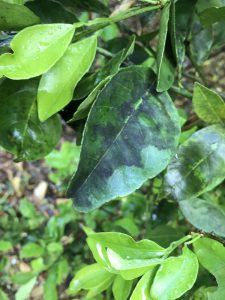That unsightly black stuff
When a black film we call sooty mold visits your plants and covers the leaves you can be sure of at least one thing. You have an insect problem. Most of you have seen this thin soot like layer on your Citrus, Gardenia, and a host of other plants. The question I get most is “Will it kill my plant?”.

The real culprit
Let’s take a look at the insects that are causing sooty mold and how. Then we’ll examine some of the solutions. Sooty mold is actually a fungus that grows on the secretion of sap-sucking insects. Insects, such as aphids, scale, meallybugs, and whiteflies, have piercing and sucking mouth part that literally suck the plant juices out of stems and leaves. What comes ou the other end is the honeydew. The secretion is commonly known as honeydew and it is also a favorite food for colonies of ants. Honeydew is a sticky sweet substance collected by ants. Ant have been known to farm insects that excrete honeydew. By farming, we mean they protect the insect colonies from predators, such as ladybugs. There are also claims that they might move the insect to other plants to spread the colonies. honeydew excreting insects contribute to the growing conditions suitable for the growth of sooty mold. In extreme conditions the mold can become so thick that it interferes with photosynthesis of the plant but this mostly it contributes to just looking ugly. Ants running up and down the branches of you plants are also an indication of an insect problem since often the ants begin harvesting the honeydew before the sooty mold begins to grow. For the sooty mold to grow a sooty mold fungal spore will have to find it’s way to the honey dew and this may not occur in every instance.

Getting rid of the sooty mold may be as simple or complicated as getting rid of the insects. The mold depends on a continuous supply of excreted honeydew to survive. If the insects are eliminated then the source of the molds food is eliminated.
Steps to success
Horticultural oil sprays can kill the insects by coating the insect’s body and interfering with their respiration. They can also loosen the mold so that it comes off more easily. Horticultural oils should be sprayed early in the day before the temperatures become too hot to avoid plant damage. Soap based insecticides alos worked on soft bodied insects. Like oils, they disrupt the insects respiratory system and break down the insects outer body shell, chitin. skin of the insect. Insecticidal soaps are specifically produced and sold for the purpose of killing target insects on plants are fairly safe for humans. Insecticidal soaps and dish soaps however can sometimes cause leaf burn on certain plants and it might be better to test them on a small area of the plant before you spray the whole plant. Often pubescent, plants or plants with fine hairs such as tomatoes, do not take well to soaps. Neem oil, natural oil extracted from seeds of neem trees, interferes with the growth of insects and keeps them from reaching the adult reproductive stage. Neem oil can also be an effective fungicide which could make it useful to break down the sooty mold. These types of insect controls are safer for humans and the environment and are always recommended to use first to minimize insect populations before other harsher chemicals are to be considered. With these types of controls insects are killed in a way that they cannot form an immunity too thus lessening the population and the chances of them forming immunity to chemical forms of control.
That’s the news from your Hometown Gardener.You can email David Austin at davidaustin@ufl.edu for more information. Please like my Hometown Gardener page on Facebook and stay up with the latest gardening info in Florida’s Heartland.
Need answers?
Have a plant problem, a bug to ID, or any other horticulture related problem? Come see us at the Master Gardener help desk in the UF/IFAS Cooperative Extension office. We are at 4509 George Blvd., Sebring in the Bert Harris Agricultural Civic Center. Master Gardeners are on duty from 9:30 to 3:30, Monday through Friday. You can also call us at 863 402-6540
Keep in touch!
Sign up for our Master Gardener Newsletter Here
Following me on Facebook at Hometown Gardener Join our Facebook groups, Highlands County Master Gardeners, Science Based Florida Gardening Answers, Central Florida Butterfly and Pollinator Club, and Heartland Beekeepers.
Highlands County Master Gardener Class starts January 25th. Email me to learn more.
Read my other blogs by clicking here.
 1
1
